Finding the right strategies to grow your business is a challenging task. One strategy might work for an organization, and fail while employed by another. This is where you can use the Ansoff matrix to help you. This invaluable tool allows you to write down and explore all the options at your disposal for getting the most out of your business.
In this article, we are going to explain what the Ansoff matrix entails and let you analyze an Ansoff matrix example for three of the most successful companies in the world. Besides, you can also find a ready-made template that aids you map your own matrix greatly. Keep reading.

What Are the 4 Strategies of the Ansoff Matrix
The Ansoff matrix is such a powerful tool for strategic planning that every entrepreneur needs to know how to do it. The concept was created by Igor Ansoff in 1957, from whom the framework takes its name.
Visually, an Ansoff matrix is rather simple as it consists of two axes, the X-axis refers to the products, and the Y-axis to the markets. Then, what the Ansoff growth matrix does is add four different strategies, represented by the four quadrants. These four strategies show you how to grow your business based on existing products and markets and new products and markets. This means that you can also use the Ansoff matrix to see the risk of possible future moves.
Let’s see in more detail of what the four strategies of the Ansoff growth matrix are:
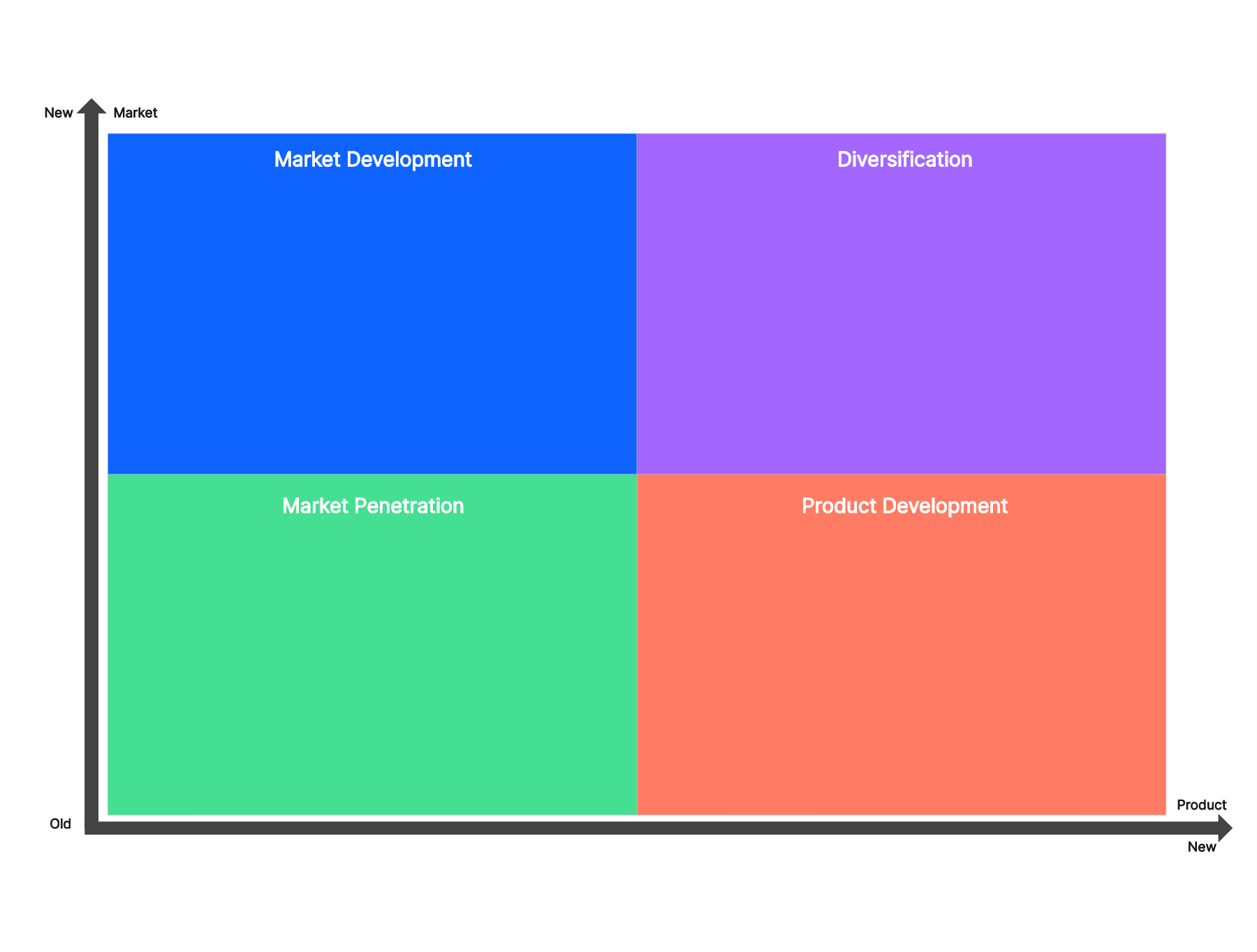
- Market Penetration – this is probably the most straightforward strategy in the Ansoff growth matrix. It entails trying to market your existing products to existing markets, meaning that is a low-risk strategy. This main goal is to secure your dominance in that particular market.
- Market Development – the next quadrant in the Ansoff matrix is when you are trying to market your existing products to a new market. In an Ansoff matrix, a new market can be either a new geographical region or a new customer segment. Of course, this comes with greater risk as you need to perform thorough market research before you try anything.
- Product Development – this quadrant of the Ansoff matrix refers to the strategy when you want to develop and launch a new product in an existing market. This strategy should focus on Research and Development, as well as finding the market’s gaps in order to introduce an innovative product that satisfies their needs.
- Diversification – the last and riskiest strategy in an Ansoff matrixis diversification. As its name suggests, this strategy is about launching a new product in an entirely new market.
What Is the Ansoff Matrix Used for
As you can see, an Ansoff growth matrix is a strategic tool that can help companies recognize potential in existing and new markets. That’s why it is widely used in the corporate world as it allows businesses to analyze the risks and rewards from various strategies.
In more detail, the Ansoff matrix is used for:
- Market analysis – first of all, an Ansoff matrix will show you where you are in the market right now, and whether there are opportunities to expand into a new market or launch a new product.
- Identification of new markets – in this matrix, you can determine if your company is in a position to try for a new market.
- Risk assessment – since you can see all four strategies in the Ansoff matrix, you are in a position to compare the risks associated with each one. This will allow you to make an informed decision before you invest in a strategy.
- Strategic decision-making – this framework as a whole, supports strategic decision-making as it enables you to think about how to evolve your business in the long run.
Pros and Cons of the Ansoff Matrix
The Ansoff growth matrix has become such an invaluable framework because it has numerous benefits for businesses. Namely, these are:
- It is a simple and intuitive tool – the matrix is very easy to create and understand. Therefore, all team members can recognize at a glance what each strategy entails.
- It incorporates the risk factor – every strategy is associated with risk to some degree. However, there are tools that don’t really take that into consideration. The Ansoff matrix though, makes sure that you understand the risk associated with each one of the four strategies.
- It provides you with a comprehensive analysis – in this framework, you explore multiple options and not just one. This way, you can spot the strategy that meets your requirements.
Nevertheless, as with every other tool, the Ansoff growth matrix also has its drawbacks. Realizing them will help you better utilize the tool. The most noteworthy limitations of this framework are:
- It doesn’t include the competition in the market – as you already know, what your competitors are doing influences your strategies. That’s why you should make sure that you also consider that before taking any action.
- It doesn’t consider the timing – another crucial factor for a strategy’s success is the timing.
- It shifts your emphasis on growth – even though growth is important, it’s not the only thing that a business should focus on. For example, you also need to consider cost control and operational efficiency among others.
3 Ansoff Matrix Examples for Business Growth
Ansoff Matrix Example – Apple
The first Ansoff matrix example that we are going to examine is about Apple. The tech giant is already a dominating force in the industry. However, there are still ways to grow and become even more powerful. Here is this Ansoff matrix example:
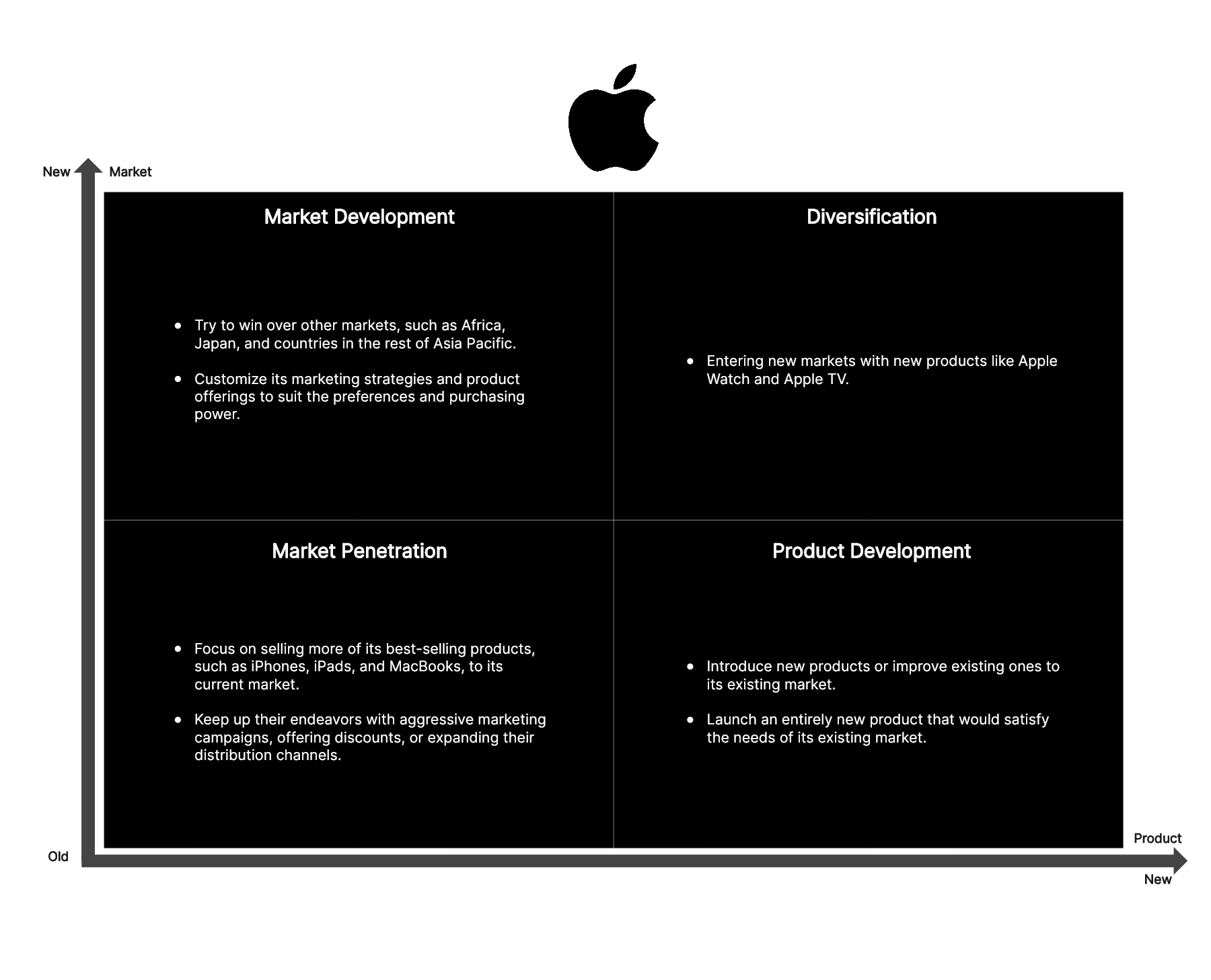
Market Penetration: In this strategy, Apple could focus on selling more of its best-selling products, such as iPhones, iPads, and MacBooks, to its current market. As of June 2023, the company operates in 26 countries by opening 526 stores. Therefore, they can keep up their endeavors with aggressive marketing campaigns, offering discounts, or expanding their distribution channels.
Market Development: Apple could focus on entering new markets with its existing products. Despite the company’s success, the biggest part of its sales comes from America. Therefore, the company can try to win over other markets, such as Africa, Japan, and countries in the rest of Asia Pacific by customizing its marketing strategies and product offerings to suit the preferences and purchasing power of these regions.
Product Development: Another strategy would be for Apple to introduce new products or improve existing ones to its existing market. For instance, the new iPhone models have advanced features that increase the market’s hype. Another idea would be to launch an entirely new product that would satisfy the needs of its existing market.
Diversification: The last strategy for Apple is to diversify its business by entering new markets with new products. In the past, Apple has already done that successfully with the introduction of the Apple Watch. On the flipside, Apple TV+ was a less successful diversification for the company.
Ansoff Matrix Example – Starbucks
The following Ansoff matrix example is about Starbucks, another powerful company in its industry. Let’s see what this framework will look like for this type of company:
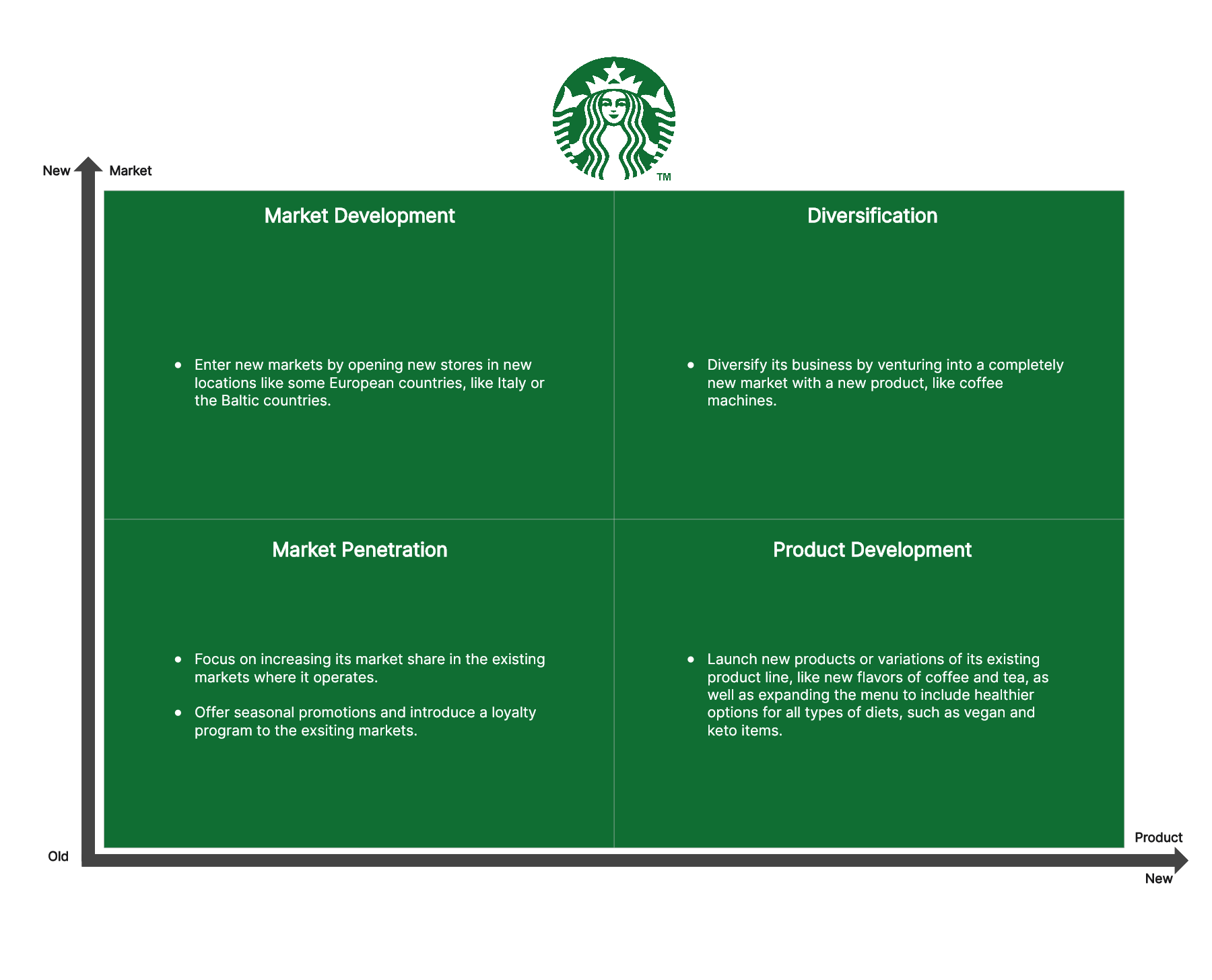
Market Penetration: First of all, Starbucks can focus on increasing its market share in the existing markets where it operates. As of 2022, the company has 35,711 stores with the majority of them operating in the US. To boost the existing markets, the company can offer seasonal promotions and introduce a loyalty program.
Market Development: The next strategy is Starbucks focusing on entering new markets by opening new stores in new locations. For example, the company doesn’t have a strong presence in some European countries, like Italy or the Baltic countries. However, before doing that, the company should analyze coffee culture in these areas to find what the general public of looking for.
Product Development: Another strategy is for Starbucks to launch new products or variations of its existing product line. For instance, this could include the introduction of new flavors of coffee and tea, as well as expanding the menu to include healthier options for all types of diets, such as vegan and keto items.
Diversification: Starbucks could also diversify its business by venturing into a completely new market with a new product. For example, it could start creating its own coffee machines that other cafés could buy.
Ansoff Matrix Example – Nestle
The final Ansoff matrix example that we are going to see is about Nestle. This multinational company is in the food and beverage industry and has solidified itself as one of the key players. This is how this framework can be applied to this giant company:
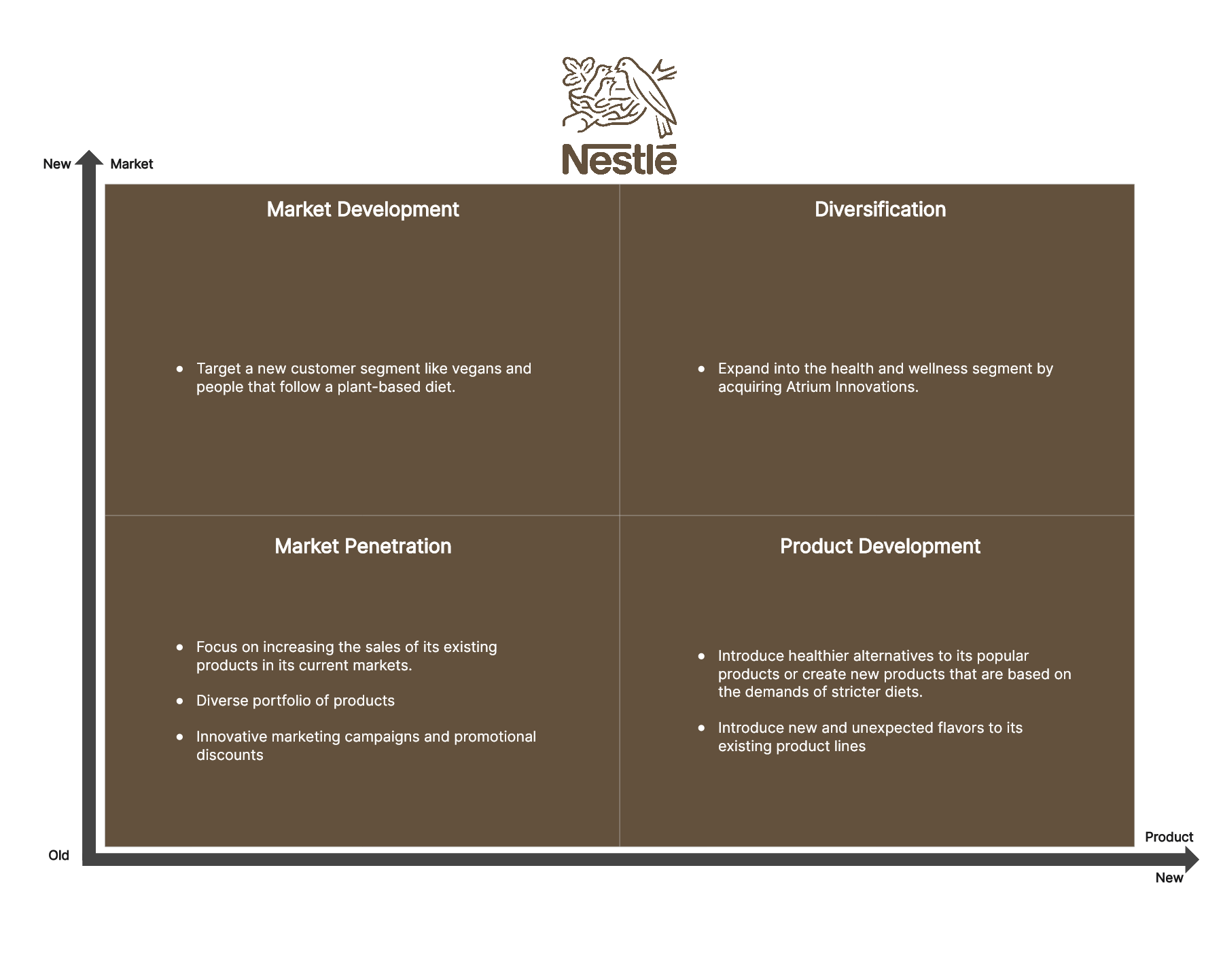
Market Penetration: The first strategy for Nestle is to focus on increasing the sales of its existing products in its current markets. According to its official website, the company was established 150 years ago, and right now it operates in 188 countries. The company already has a diverse portfolio of products and it can boost its sales with innovative marketing campaigns and promotional discounts.
Market Development: Another strategy for Nestle could be to focus on entering new markets. Since it already has a presence almost in every country of the world, it could target a new customer segment. For example, it can target vegans and people that follow a plant-based diet by customizing its product offerings to match their preferences.
Product Development: Nestle could also develop new products to cater to evolving consumer preferences. For instance, it could introduce healthier alternatives to its popular products or create new products that are based on the demands of stricter diets. Another idea could be to introduce new and unexpected flavors to its existing product lines.
Diversification: The final strategy for Nestle could be to diversify its product portfolio. For instance, it has already expanded into the health and wellness segment by acquiring Atrium Innovations.
How to Use the Ansoff Growth Matrix
All of these examples show you how even big companies can benefit from the Ansoff matrix. Therefore, it is more than obvious that you can also use it to help your organization grow and reach its full potential. The steps for using the Ansoff growth matrix are the following:
- Create the empty matrix – you can either start from scratch or find a template that will make the creation of your Ansoff matrix much faster. Customize the matrix to fit your needs.
- Analyze your strategies – then, write down all four strategies into the relevant quadrants. Don’t hesitate to think big as all available options can inspire you to find the right strategy for your company.
- Perform a risk analysis – before deciding on a strategy from the Ansoff growth matrix, it is important to understand the risks associated with it.
- Prepare for any outcome – along with the risk analysis, you can also prepare for any outcome. This will work as damage control in the case where your strategy didn’t go as planned.
- Select which strategy is the best – now you can make an informed decision and start implementing the strategy you’ve chosen.
Ansoff Growth Matrix Template & Tool
The easiest way to create your own Ansoff matrix is to use a ready-made template. Boardmix has created a well-designed and professional Ansoff matrix template that you can immediately start using. Find the template in Boardmix’s large library and create your matrix with just a few, simple steps.
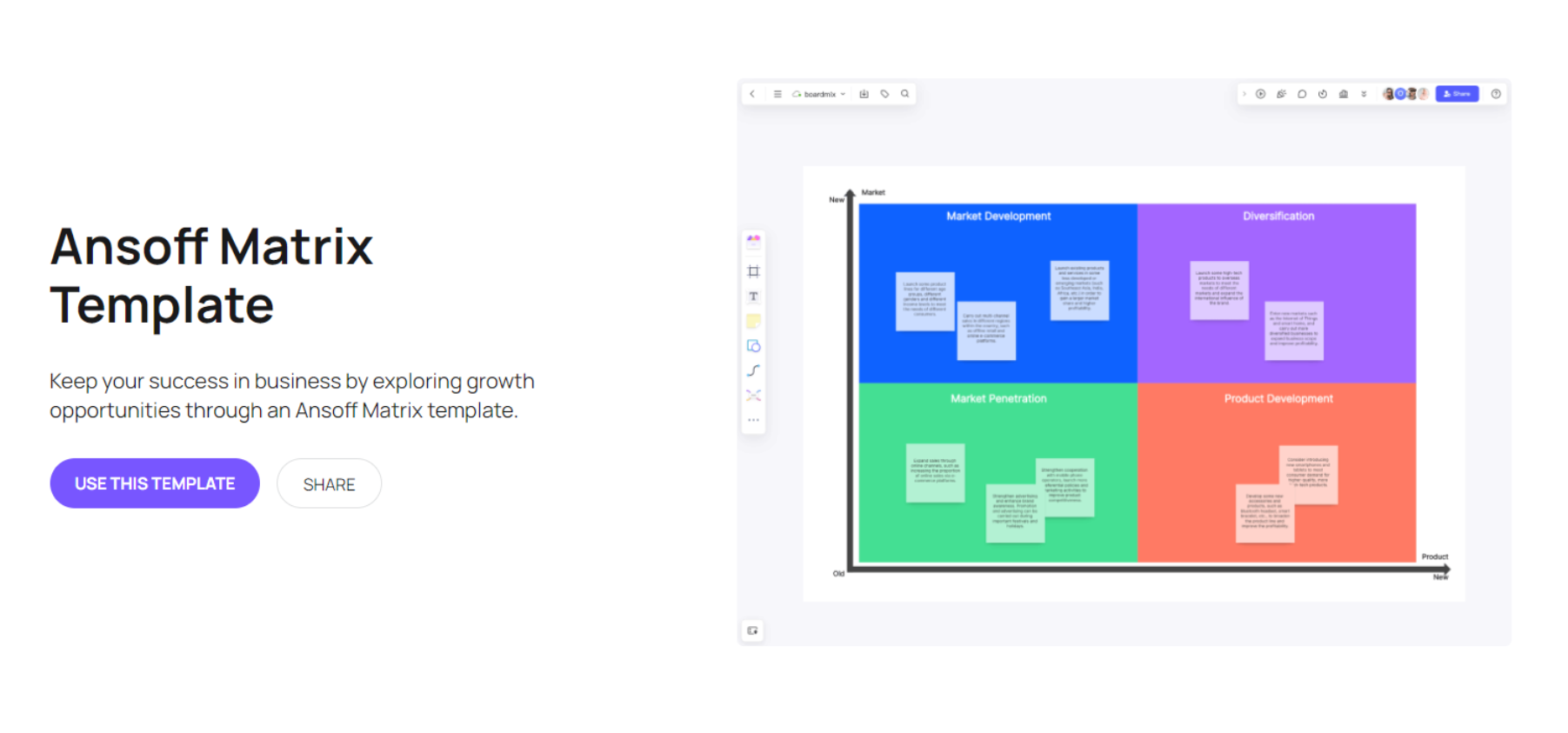
Moreover, Boardmix provides various tools that can help you analyze data and enrich your matrix. Create your account in Boardmix for free to access your workspace and start creating any type of diagram you need for your business.
FAQs about Ansoff Matrix
Which Ansoff Matrix growth strategy is considered the riskiest?
The riskiest Ansoff growth matrix strategy is Diversification. This strategy is about launching a new product in a new market. This means that you have no prior knowledge of the market or how the product will perform. That’s why it entails both great risk and great reward. However, before you decide to employ this strategy, make sure that you have conducted thorough market research.
What is the difference between SWOT analysis and Ansoff Matrix?
Even though both the SWOT analysis and the Ansoff matrix are tools used for strategic planning, they are quite different. The most significant difference is that they focus on separate things. The Ansoff matrix primarily focuses on growth strategies, while the SWOT analysis has a broader view since it analyzes all internal and external factors.








